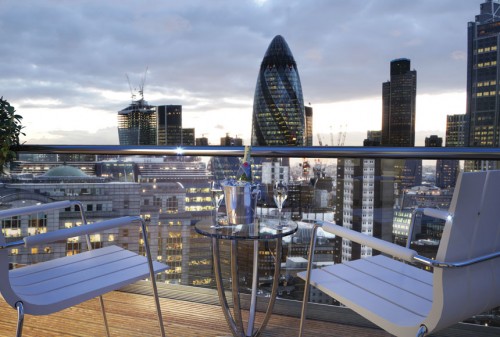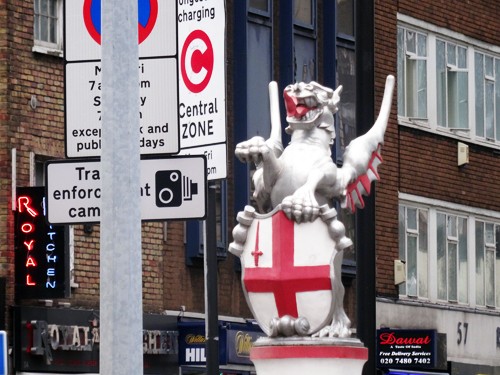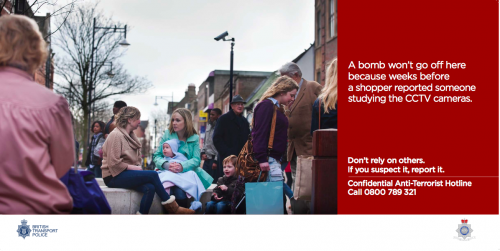Epilogue
The MIRRORCITY exhibition closed last Sunday, and with it the Nor residency. But I had unfinished business. On October 30th, while I was attempting to walk the perimeter of the modern London Wall, I was stopped and held by private security guards and questioned by the police, for the suspicious activity of taking photographs: for the potential crime of paying attention.
Thanks to that intervention, I failed to complete the day’s journey, so on Monday I set out to close the circle. From Vauxhall to King’s Cross via the Elephant, the Old Kent Road, Tower Bridge, Aldgate, Shoreditch and the City Road. As before, I set out to photograph every camera I saw, which could possibly see me. There were 562 of them. (And the Map of the Nor has been updated with the lot, as well as previous expeditions.)
(I’ve since been reminded that there are official British Transport Police posters warning people to be suspicious of people like me, those crazy paranoids who pay too much attention to the infrastructure of a surveillance society:)
This territory is one I’m intensely familiar with, yet is always rendered strange and new by every passage. There are the paranoid landmarks – the unmarked MI5 Buildings on Kennington Road, the emergency broadcast speakers on the Minories – and the more pleasant curios, like the Freedom Bookshop in Whitechapel and Joseph Grimaldi’s grave in Islington. For the first time on a Nor walk, I had no run-ins with security, private or otherwise; instead there was a sort of shit half-hearted junkie mugging attempt on Tower Bridge Road, just where unreconstructed Bermondsey meets the new gentrified zones. But it was the latter that were more terrifying.
While I was walking, the internet and then the media were much exercised by a promotional video for one of these schemes, a psychotic power fantasy by the developer Red Row Homes, in which a dead-eyed cypher ascends to his rightful place in the Archersphere. But if you walk, these attitudes are hardly new. From Cityscape on Commercial Road to Bézier at Old St (a design so weakly inhuman it’s named after a computer drawing tool), all of these developments promise some variation on exclusivity and luxury. Lexicon on City Road, improbably engineered by the same team as the Burj Khalifa, promises to be “the place to write your own story”, while Eagle Black just down the road is “fearless and unapologetic”. It’s “fun at the top” apparently, in one of the 22 “decadent residences and penthouses”. Meanwhile at the Elephant, as expertly documented by Dan Hancox, the enclosure of public space and the eviction of the local population continues apace.

Over it all watch the cameras, some two thousand of them, at a guess (I took 896 photos, but many of them contain multiple cameras). For a twelve mile loop, that’s one every 30 feet. Whose they are, what they’re looking for, or even why they’re there, is often hard to figure out.
Beyond the many private cameras, a series of Freedom of Information Requests reveals that Transport For London alone operates 1,517 automated number-plate reading cameras; 646 for the Congestion Charge, 342 for the enforcement of the Low Emission Zone, 498 for general traffic tracking, and 31 speed cameras. Like TfL’s road cameras, all of this information accrues to the security services as well.
Why elide development and surveillance in this way? What do they have in common beyond the generally unpleasant shadow they cast over those of us who still operate on the ground – or what the signs at Canary Wharf charmlessly refer to “street level”? For me, both processes represent an abstraction from everyday life, the retreat of power into unquestionable, unassailable, and unseen elevated spaces. They share a contempt for the everyday, for the shared space of the city, for its history and fabric, for its living.

This is supposed to be an epilogue, but there is so much more that is unsaid. One theory bleeds into another. During the third expedition, as I rode through Cutthroat Wood on the long ridge towards Ruislip, shotgun blasts echoing through the woods behind me, I realised I had a clear view down onto the runways of RAF Northolt, which I’d already written about, but not visited, in the second essay. Across the tarmac I could see the hangars where the Islanders are parked – across from them, the Netjets zone, haunt of oligarchs and, on bad days, mullahs. By the time I came to close the loop around London, I was done with cameras; all I could see were aerials on the rooftops. I wanted to look up; and further up; and further still. I want this ringing in the ears to stop.
Two days after Christmas, pushing out of London on the Greenway, I stopped in the bright morning light in the middle of the Olympic Park. Here’s where it starts and ends, in case you haven’t noticed, among the ghosts of Sinclair, Petit and Keiller; Williams, Lanham and Mubenga. There’s no metaphor left in this frozen ground. Filtered, bulldozed and regenerated, the land is exhausted. Even the match factory rocket towers seem too still, too obvious. Nothing moves in the still air but the flickering, unseen waves of energy overhead.
If there’s one thing I’ve learned, it’s that nobody cares. Everything is true and nobody cares. “Conspiracy”, as Carl Oglesby wrote, “is the normal continuation of normal politics by normal means.” The Nor ends here, for now: what was supposed to be a performance and a purging ritual bound up once more with new turned-over secrets. See you anon.
